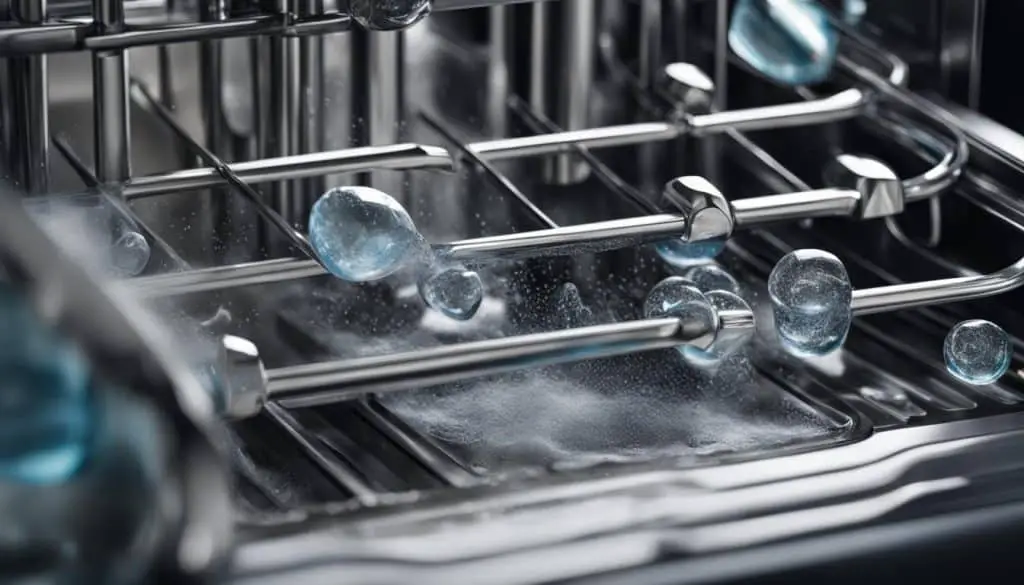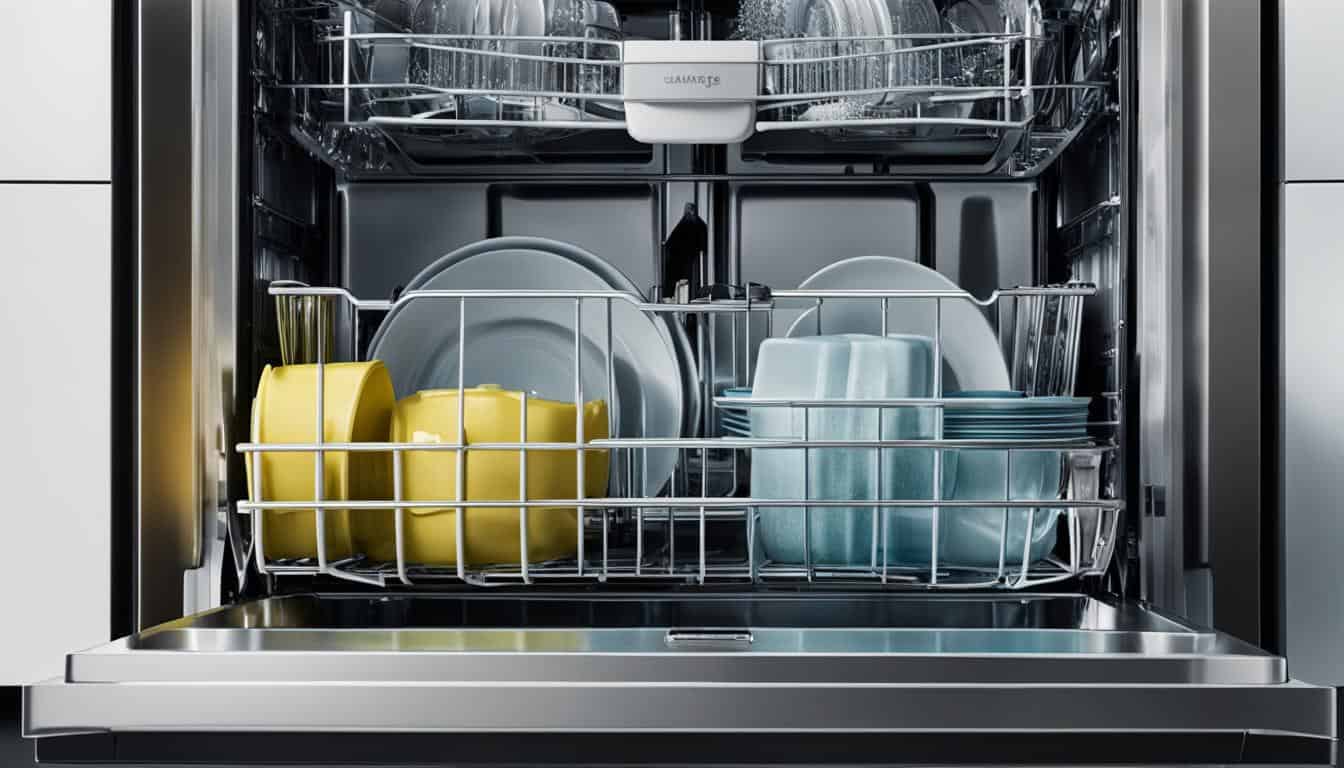When it comes to washing dishes, one important factor to consider is water usage and the resulting environmental impact. Dishwashers typically use less water than handwashing and air-drying combined.
However, water efficiency models are becoming increasingly common, and proper use of a dishwasher includes running full loads, which maximizes water and energy efficiency.
In contrast, air-drying uses no water, which can be appealing for eco-conscious individuals. However, the process can be time-consuming, especially for larger households.
Some studies suggest that using a dishwasher can use up to 5 times less water than handwashing dishes. It’s important to note that the type of dishwasher and how it’s used can have a significant impact on water usage.
For example, Energy Star certified water efficiency models use an average of 3.5 gallons of water or less per cycle, while older models may use up to 10 gallons per cycle.
Water usage comparison between dishwashers and air-drying
| Gallons of Water | |
|---|---|
| Dishwasher (full load) | 3.5 or less |
| Handwashing dishes | Up to 27 |
| Air-drying dishes | 0 |
As you can see, using a dishwasher with full loads is the most water-efficient dishwashing method. However, air-drying can still be a viable option to consider, especially for those who live in areas with water shortages.
Energy Consumption: Air-Drying vs. Dishwashers
When it comes to energy consumption, air-drying is the clear winner as it requires no electricity.
However, it’s important to consider whether this method is practical for your household’s dishwashing needs. Dishwashers, on the other hand, do use electricity, but more energy-efficient models are now available to help minimize your environmental impact.
To determine the most energy-efficient dishwasher for your needs, consider the unit’s Energy Star rating. This certification assures that the dishwasher meets strict energy efficiency guidelines set by the US Environmental Protection Agency (EPA).
Additionally, some dishwashers offer “eco” or “energy-saving” modes that can reduce the unit’s energy consumption during operation. Running full loads also helps optimize your dishwasher’s energy efficiency.
Comparing Energy Consumption
To provide an overview, below is a comparison of the average energy consumption per load for air-drying and using a dishwasher:
| Air-Drying | Dishwasher | |
|---|---|---|
| Electricity Consumption | N/A | Approximately 1.5 kWh |
| Water Consumption | Zero | Approximately 5 gallons |
As you can see from the table, air-drying is the most energy-efficient method for drying dishes. However, using a more energy-efficient dishwasher model and optimizing usage can help minimize the energy consumption of this method.
Detergent and Rinse Aids: Air-Drying vs. Dishwashers
Both air-drying and dishwashing methods require cleaning products, such as detergent and rinse aids. While dishwashers typically concentrate these products, potentially reducing overall use, it’s essential to choose eco-friendly options for both methods.
Eco-friendly cleaning products are made from sustainable materials and are less harmful to the environment. By choosing eco-friendly brands, you can minimize your environmental impact.

When selecting cleaning products for your dishwasher or air-drying method, opt for ones that are concentrated to reduce waste and packaging. Concentrated products are also typically more cost-effective.
Another eco-conscious choice is to choose products that do not contain phosphates, which can harm aquatic life.
It’s also helpful to consider the type of water in your area when choosing cleaning products. Soft water areas do well with all-purpose detergents, while hard water areas may require specialized products to ensure optimal cleaning power.
Rinse aids can help with ensuring spot-free dishes and reducing the buildup of mineral deposits caused by hard water.
Cleaning and Hygiene: Air-Drying vs. Dishwashers
When it comes to cleaning and hygiene, dishwashers offer advantages over air-drying. Most dishwashers come with hot water cycles and sanitizing features that effectively eliminate bacteria and viruses.
This is particularly important for households with young children, elderly individuals, or people with weakened immune systems.
In contrast, air-drying might not achieve the same level of sanitization, and can leave residue, especially on air-dried plastics. Additionally, air-drying can lead to water spots, particularly in areas with hard water.
If you live in a hard water area, you might have experienced white spots and film on your clean dishes and cutlery. This is caused by minerals dissolved in the water that form a deposit on the surface. Using rinse aid in your dishwasher or wiping dry with a soft cloth after air-drying can minimize this issue.
| Air-drying | Dishwasher | |
|---|---|---|
| Cleaning power | May leave residue, especially on plastics | Hot water cycles and sanitizing features eliminate most bacteria and viruses |
| Water spots | More likely in hard water areas | Rinse aid use can minimize this issue |
Overall, while air-drying offers a simple and convenient way to dry your dishes, dishwashers are the way to go for optimal cleaning and hygiene.

Usability and Convenience: Dishwashers vs. Air-Drying
When it comes to the usability and convenience factor, dishwashers have a clear advantage over air-drying. Handwashing and air-drying dishes take time and effort, which can be a challenge for individuals with busy lifestyles or large households.
Dishwashers not only save time and effort, but they also eliminate the need for dedicated space for air-drying. This can be a significant consideration for those with limited counter space or who prefer a clutter-free kitchen.
Additionally, dishwashers minimize the breakage risk for delicate dishes when proper rack placement is used. This is particularly important for households with expensive or sentimental dishware.
However, dishwashers do require occasional cleaning and maintenance to ensure they continue to function efficiently. On the other hand, air-drying dishes is essentially maintenance-free.
Dishwashers vs. Air-Drying – A Comparison of Usability and Convenience
| Factors | Dishwashers | Air-Drying |
|---|---|---|
| Time and effort | Less time and effort required | More time and effort required |
| Space considerations | Eliminates need for dedicated air-drying space | Requires dedicated air-drying space |
| Breakage risk | Minimizes risk with proper rack placement | Increases risk |
| Maintenance | Requires occasional cleaning and maintenance | Maintenance-free |
Ultimately, whether you choose to use a dishwasher or air-dry your dishes comes down to personal preference and your specific needs. Consider the factors that are most important to you, such as time, convenience, and breakage risk, when making your decision.
Determining the Best Dishwashing Method: Air-Drying vs. Using a Dishwasher
Choosing between air-drying and using a dishwasher depends on several factors that need to be carefully considered. While both methods have advantages, assessing their environmental impact, cleaning power, maintenance requirements, and convenience will help you determine the best approach for your specific circumstances.
Environmental Impact and Water Usage
When it comes to environmental impact and water usage, dishwashers are generally more efficient than handwashing and air-drying combined. However, it’s important to consider using water efficiency models and running full loads for optimal performance.
On the other hand, air-drying is an energy-free option, which can help reduce your household’s carbon footprint. However, if you live in a hard water area, air-drying may result in water spots and residue on your dishes.
Cleaning Power and Hygiene
Dishwashers offer several benefits when it comes to cleaning power and hygiene. They have hot water cycles and sanitizing features that can effectively kill most bacteria and viruses. In contrast, air-drying might not achieve the same level of sanitization and can leave residue, especially on plastic dishes. Therefore, if hygiene is a priority, using a dishwasher is a better option.
Usability and Convenience
When it comes to usability and convenience, dishwashers are a great option, freeing up time and effort compared to handwashing and air-drying.
They eliminate the need for dedicated space for air-drying and minimize the risk of breakage for delicate dishes if proper rack placement is used. However, dishwashers do require occasional cleaning and maintenance, while air-drying is essentially maintenance-free.
When deciding which method to use, weigh the pros and cons of air-drying versus using a dishwasher based on your priorities. If you prioritize convenience, using a dishwasher is the way to go. However, if you’re committed to minimizing your environmental impact, choose air-drying. You can also opt for a combination approach that utilizes both methods.
Tip: Implement eco-friendly dishwashing practices to maximize efficiency and minimize environmental impact. Consider using energy-efficient models, running full loads, and choosing eco-friendly products.
Additional Tips for Eco-Friendly Dishwashing
To further promote eco-friendly dishwashing, there are various energy-saving tips and water-saving tips that you can implement in your daily dishwashing routine.
Energy-Saving Tips
- Run your dishwasher during off-peak hours to reduce electricity demand.
- Consider using energy-efficient dishwasher models, which can consume less electricity than older models.
Water-Saving Tips
- Use the dishwasher’s eco-mode, which reduces water usage by up to 30% compared to standard modes.
- Run full dishwasher loads whenever possible to optimize water use.
It’s important to note that choosing eco-friendly products for your dishwashing routine can also have a positive impact. Opt for products with eco-friendly certifications or those that have been developed with minimal environmental impact in mind.
You can also make eco-conscious choices by reducing the amount of waste generated by your dishwashing routine. Avoid single-use items and consider reusable alternatives, such as washable dishcloths instead of paper towels.
Implementing these simple tips can help you reduce your environmental impact while still achieving sparkling clean dishes.
Final Thoughts
After weighing the various factors, you may still find it difficult to decide between air-drying and using a dishwasher. Ultimately, it comes down to individual preference and your specific circumstances.
Some may prefer the efficiency and convenience of a dishwasher, while others appreciate the simplicity and energy-saving benefits of air-drying.
Consider experimenting with both methods and perhaps even combining them, using a dishwasher for larger loads and air-drying for smaller ones.
Remember to prioritize factors like efficiency, hygiene, and convenience to determine the optimal approach for your dishwashing routine.
By making eco-conscious choices and implementing energy- and water-saving tips, you can reduce your environmental impact regardless of which method you choose.
Ultimately, the most important thing is to find a dishwashing routine that works for you and your household. So go ahead and try out different methods until you find the perfect combination that suits your needs!


